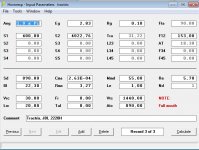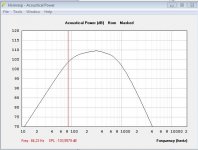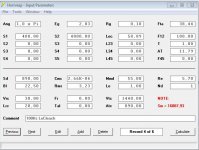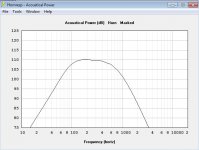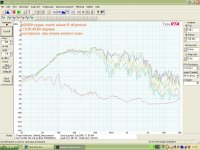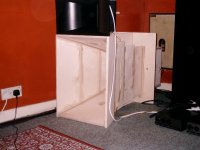Hi! I have been trying to get an answer to the above question before making sawdust in my garage. It will be my first diy horn-project. I`m planning to mate this mid-bass horn with JBL 2360 + JBL 2404 above, and BR-box with 2x 15" below. Frequency range about 100-650Hz. Driver is JBL 2220H. It would be nice with a horn that could go down to about 80-90Hz, but max mouth size is about 80x50cm, and max length about 85cm (incl back chamber).
A 150Hz Tractrix with throat area 400cm2, and mouth 4000cm2, length about 31cm seems to be possible, according to Hornresponse, but a shortened JMLC would also fit the size requirements, but would not have a 90 degrees (or more) flare tangent angle. So my question is how, how audible is it to use a shortened JMLC horn (or Hypex or Exponential) compared to a fully formed Tractrix?
Placement will be about 55cm above the floor, close to a corner. Walls and floor is concrete. Is the mouth reflections mostly at the lowest frequencies? The sound quality of voices are more important than drum kick, but if I can have both..
I will use PC based active crossovers and DSP for frequency and time correction.
A 150Hz Tractrix with throat area 400cm2, and mouth 4000cm2, length about 31cm seems to be possible, according to Hornresponse, but a shortened JMLC would also fit the size requirements, but would not have a 90 degrees (or more) flare tangent angle. So my question is how, how audible is it to use a shortened JMLC horn (or Hypex or Exponential) compared to a fully formed Tractrix?
Placement will be about 55cm above the floor, close to a corner. Walls and floor is concrete. Is the mouth reflections mostly at the lowest frequencies? The sound quality of voices are more important than drum kick, but if I can have both..
I will use PC based active crossovers and DSP for frequency and time correction.
Consider making it J shaped with the driver at the top. used this driver to do so on a hypex IIRC. It's been 15 years since I dismantled it (moved to a much smaller place) so Idon't recall the details. Just offering it as a suggestion. Designed with Horn RESP.Driver is JBL 2220H. It would be nice with a horn that could go down to about 80-90Hz, but max mouth size is about 80x50cm, and max length about 85cm (incl back chamber).
Good. Anything else will be a horror to integrate and offer some sonic compromises as some flears may mask others to get time alignment.I will use PC based active crossovers and DSP for frequency and time correction.
check this mid bass horn out.
Conical Midbass Fronthorns – Volvotreter Homepage
You can also do a search on Dr. Bruce Edgar Titan horn system. Dr. Bruce wrote horn building articles in Speaker Builder magazine in the 1980's and 1990's. Good luck
Conical Midbass Fronthorns – Volvotreter Homepage
You can also do a search on Dr. Bruce Edgar Titan horn system. Dr. Bruce wrote horn building articles in Speaker Builder magazine in the 1980's and 1990's. Good luck
Hi! My first attempt will be a straight horn, I think. Easier construction, and probably easier to get response at higher frequencies?Consider making it J shaped with the driver at the top. used this driver to do so on a hypex IIRC. It's been 15 years since I dismantled it (moved to a much smaller place) so Idon't recall the details. Just offering it as a suggestion.
Yes, I`ve been lurking at Volvotreters site, but it is a bit too deep. Also, I get the impression the Traxtrix sound cleaner?check this mid bass horn out.
Conical Midbass Fronthorns – Volvotreter Homepage
You can also do a search on Dr. Bruce Edgar Titan horn system. Dr. Bruce wrote horn building articles in Speaker Builder magazine in the 1980's and 1990's. Good luck
So you say that a shortened horn is ok at midbass frequencies? Have you experienced the differences yourself? I have not, but have read some threads and articles about it. Snipped from an interview with Bruce Edgar in "Speaker builder":I modellen LaScala size horn and really only mouth size and horn length matter. Type of flare does not in such small badshorts.
"Bruce: Yes, those particular horns were made for me by Bill Firebaugh, the Well Tempered arm inventor. He's also been interested in horns. He showed the paper horns to me. I said, "I've got to have a pair of these." So he made up a pair of horns. They are a round Tractrix horn and a round exponential horn. You talk through them like megaphones. When you talk through the exponential horn, people can hear the coloration to your voice, which is a certain resonant quality that wasn't there before. You talk through a Tractrix horn and you don't hear it. It's completely open."
For the midhorn the mouth is large and horn is long compared to its freqency range. As model in horn response shows that driver parameters and size of back Chambers affect the shape of the shoulder at the highpass of the horn. Howe er, frequencyresponse is not everything so they might sound different especially in the higher range.
I modellen LaScala size horn and really only mouth size and horn length matter. Type of flare does not in such small badshorts.
The OP wants 80Hz LF response and the LS won't do it. I've owned a couple of factory units as well as built a couple.
Nope, not for a truncated midbass. They also don't load a s well at the bottom of the desired range; for example the Edgar midhorn, though having a flare of 350Hz, drops off below 500Hz. You can use a sqrt2 as a multiplier safely.Yes, I`ve been lurking at Volvotreters site, but it is a bit too deep. Also, I get the impression the Traxtrix sound cleaner?
I've also built the trax midbass horn on his site. It didn't start out as his design, but Erik's plans are better then the originals.
Not particularly difficult if you use straight section approximations. HF response on mine was around 500Hz. What messes with midbass is folding a la the Khorn and LS etc. i developed my midbass horns to get rid of the chestiness in the upper range of my KHorns.Hi! My first attempt will be a straight horn, I think. Easier construction, and probably easier to get response at higher frequencies?
For the midhorn the mouth is large and horn is long compared to its freqency range. As model in horn response shows that driver parameters and size of back Chambers affect the shape of the shoulder at the highpass of the horn. Howe er, frequencyresponse is not everything so they might sound different especially in the higher range.
I`ve tried to simulate the different horn flares in Hornresp, and I don`t get much ripple in the SPL-response, even though the mouth is too small to get 90 degrees (or more) flare angle. Shouldn`t the ripple be visible in the Hornresp simulation? Anyway, is it correct that at higher frequencies the horn start to beam, and the flare angle is perhaps not that important?
OK, thanks!For the midhorn the mouth is large and horn is long compared to its freqency range. As model in horn response shows that driver parameters and size of back Chambers affect the shape of the shoulder at the highpass of the horn. Howe er, frequencyresponse is not everything so they might sound different especially in the higher range.
But I mean to compare with a Tractrix that is not truncated, but with less bass, see enclosed screenshots. I`m willing to sacrifice bass extension for cleaner midrange, so this Tractrix is for about 150Hz. I assume that it will work to 150Hz, as simulated, no multiplication with sqrt(2)? See also a JMLC simulation at 100Hz, but this is not fully formed. So this is my dilemma, if the shortened JMLC sound worse I will build the Tractrix.Nope, not for a truncated midbass. They also don't load a s well at the bottom of the desired range; for example the Edgar midhorn, though having a flare of 350Hz, drops off below 500Hz. You can use a sqrt2 as a multiplier safely.
I've also built the trax midbass horn on his site. It didn't start out as his design, but Erik's plans are better then the originals.
I looked at Vovotreters Tractrix. It seems that the simulation isn`t for the posted plan. Didn`t try to simulate with the figures from the plan, but with a 15" driver I guess it will be about the same as my screenshot below?
Maybe you have listened to both the Tractrix, and the conical 77Hz on his site? The conical is a bit deep for my room.
Attachments
Last edited:
I was not talking about truncated traxes; never built any. As to SQ between the150Hz trax and my 80Hz hypex in the MR? I doubt you'll ever hear it.
As to the sqrt2 ratio, just look at Erik's site. The Edgar 350Hz was designed with a 350Hz flare rate, yet drops like a stone below 500Hz. I built a large 150Hz unit, and it was a cliff below 220Hz or so (IIRC from about 2003).
Don't have time for further analysis now may return to it over the w/e.
As to the sqrt2 ratio, just look at Erik's site. The Edgar 350Hz was designed with a 350Hz flare rate, yet drops like a stone below 500Hz. I built a large 150Hz unit, and it was a cliff below 220Hz or so (IIRC from about 2003).
Nope, built the 150Hz only.Maybe you have listened to both the Tractrix, and the conical 77Hz on his site? The conical is a bit deep for my room.
Don't have time for further analysis now may return to it over the w/e.
I was not talking about truncated traxes; never built any. As to SQ between the150Hz trax and my 80Hz hypex in the MR? I doubt you'll ever hear it.
Thanks!
I`m planning to mate this mid-bass horn with ........Frequency range about 100-650Hz. Driver is JBL 2220H..........but max mouth size is about 80x50cm, and max length about 85cm (incl back chamber).
So my question is how, how audible is it to use a shortened JMLC horn (or Hypex or Exponential) compared to a fully formed Tractrix?
Placement will be about 55cm above the floor, close to a corner. Walls and floor is concrete. Is the mouth reflections mostly at the lowest frequencies? The sound quality of voices are more important than drum kick, but if I can have both..
No clue, nor all that relevant with truncated mouth horns as they all suffer from audible mouth generated reflections back to the throat, so recommend a 70 Hz tractrix and ideally add an open cell foam termination to quell them, though some folks have been happy with various other materials such as plush cotton towels or similar.
Reflections from room/whatever boundaries parallel to the mouth centerline begin at ~344 m_s/2/distance and all its even, odd harmonics.
With an empirically dialed in mouth termination, see no reason why you can't 'have your cake and eat it too'
GM
Attachments
ThanksNo clue, nor all that relevant with truncated mouth horns as they all suffer from audible mouth generated reflections back to the throat, so recommend a 70 Hz tractrix and ideally add an open cell foam termination to quell them, though some folks have been happy with various other materials such as plush cotton towels or similar.
Reflections from room/whatever boundaries parallel to the mouth centerline begin at ~344 m_s/2/distance and all its even, odd harmonics.
With an empirically dialed in mouth termination, see no reason why you can't 'have your cake and eat it too'with the attached horn.
GM
ThanksWhen I was building a horn similar to the Edgar midbass using EVM15L drivers I also built a test horn for a JBL2020H. The JBL driver went a bit higher than the EV one, but the horn had to be longer.
ThanksIs this a Hypex approximation? Which driver parameter would make it neccesary to make the horn longer?
Yes a hypex horn. The JBL is a 12" driver. I think that is the main reason for the difference in length. I built these a long time ago so haven't got the hornresp models anymore but I think the throat was smaller to get a similar compression ratio, which made the horn longer.
- Status
- This old topic is closed. If you want to reopen this topic, contact a moderator using the "Report Post" button.
- Home
- Loudspeakers
- Multi-Way
- Midbass-FLH, fully formed Tractrix, or shortened JMLC (or Hyp, Exp)?
